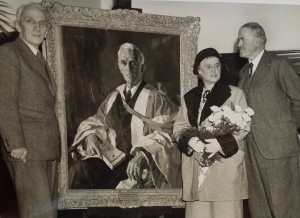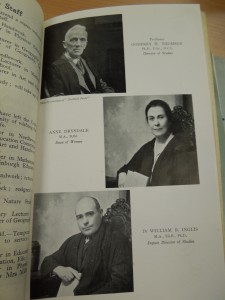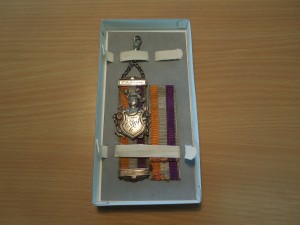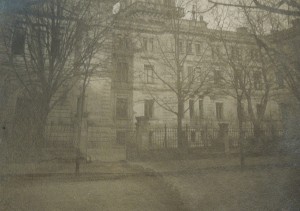Robert Heriot Westwater’s most famous portrait is probably that of Christopher Murray Grieve (more widely known by his nom de plume, Hugh McDiarmid!). But Westwater also painted two very different portraits of Sir Godfrey Thomson in honour of his retirement in 1951:
Westwater’s first encounter with Thomson was as a student training as a teacher of art at Moray House:
I remember very clearly my first sight of Professor Thomson as he passed a group of us students in the corridor. “Who”, I demanded, “Who is that chap with the terrific head?”. For the rest of my course at the training college I vainly tried to screw up courage to approach him – the art students, alas, had no class under him – to ask him if he would sit for me. But I never quite succeeded. And in the intervening years I lamented this somewhat uncharacteristic lack of “brass neck”
Moray House Magazine, March 1951
Westwater was delighted several years later on being commissioned to paint the-chap-with-the-terrific-head’s portrait! The main portrait was to be a formal one in the striking red and white academic dress of the University of Durham DSc:
Westwater had some concern with regards to Thomson’s clothing outshining him in the painting:
With most other sitters such a garb would almost inevitably lead to a “portrait of robes with head attached.” But in Godfrey’s case, not so. When he arranged himself in the chair set ready, with complete dignity and composure, it was obvious at once that even such a gown could not compete. The “terrific head” easily subdued it to its proper and subordinate place.
Moray House Magazine, March 1951
Westwater commented on the many and varied conversations he and Thomson had during Thomson’s sittings, informing the reader that they were even prone to a sing song now and again (Thomson’s secretary and students were quite used to him playing, singing, and humming Gilbert and Sullivan whenever the notion took him!). But my favourite passage by far is when Westwater gets rather verbose for his own good and waxes lyrical about the shape of Thomson’s head!:
The very bone structure of his skull begins the puzzle, for it is at once positive, virile, and yet almost frail in its delicacy. The eyes have an imperious authority and penetration, but the mouth under the forceful nose astonishes by its nearly feminine gentleness. it would be easy to cite another score of complexities, more subtle and more difficult from the painters point of view.
Moray House Magazine, March 1951
Quite! Westwater’s second portrait of Thomson was more informal, and was Thomson’s gift from Moray House :
This remained with the Thomson family for many years after Thomson’s death, eventually being donated to the University. Ever keen to see paintings around the university rather than in store, we are delighted that Thomson now hangs proud in the office of his greatest advocator! He is frequently seen and admired by a host of students and visitors.
Westwater clearly enjoyed painting Thomson, and likely he and Thomson would derive great pleasure from knowing his other portrait hangs in Moray House to to this day, reminding everyone, as Westwater put it, ‘of he whom they and I will always think of from different angles as “A Terrific Head”‘!














